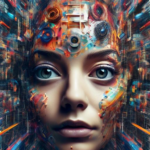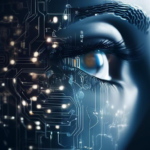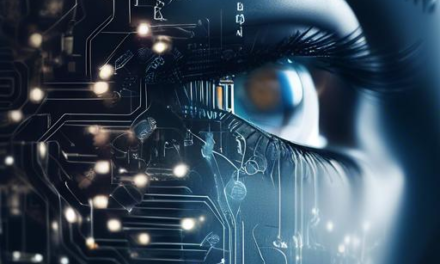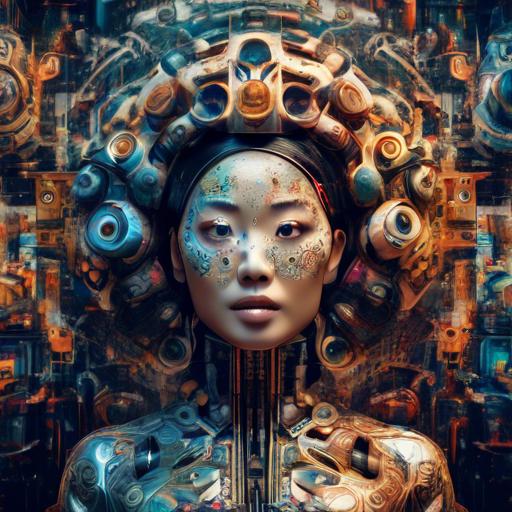Imagine a universe where boundless creativity and complex code coexist, forging masterpieces that bridge human intuition and machine precision. This is the realm of artificial intelligence (AI) art, a vibrant intersection of technology and imagination that has redefined what it means to create. As we navigate this brave new world where algorithms craft canvases, one pressing question emerges: How do we guide these digital brushstrokes to ensure fairness, originality, and ethical integrity? Enter the crucial role of regulations, acting not as restrictive chains but as harmonious conductors in this symphony of innovation. In this exploration, we will delve into how thoughtful regulations can serve as an essential framework, fostering an environment where AI artistry can flourish while safeguarding the principles that make art a distinctly human endeavor. Join us as we unravel the delicate balance of freedom and oversight in the dazzling domain of AI-created art.
Table of Contents
- Navigating the Canvas: Regulations in AI Art
- Balancing Creativity and Compliance
- The Ethical Palette: Moral Considerations in AI Art
- Guardrails for Innovation: Ensuring Responsible AI Use
- Championing Fairness: Addressing Bias in AI Creations
- Intellectual Property in the Age of Algorithms
- Fostering Collaboration: Bridging Artists and Technologists
- Policy Blueprint for a Harmonious Future
- Empowering Creators: Advocating for Art and AI
- Wrapping Up
Navigating the Canvas: Regulations in AI Art
As artificial intelligence continues to forge new paths in the art world, understanding the evolving landscape of regulations is essential for artists and developers alike. These regulations are set in place to balance creativity, innovation, and ethical considerations, ensuring that AI-generated art finds its rightful place within the broader artistic community.
- Copyright and Ownership: One of the most significant concerns is determining who holds the copyright to AI-created art. Is it the programmer, the user, or the AI itself?
- Ethical Considerations: Ensuring that AI art does not reproduce harmful stereotypes or be used for malicious practices is critical. Guidelines often recommend ethical review processes before publication.
- Transparency: Regulations may require artists to disclose the use of AI in their creations. This promotes honesty and allows viewers to appreciate the blend of human creativity and machine learning prowess.
Regulatory bodies are also setting standards for the storage and use of data employed in training AI systems. Ensuring data privacy and ethical sourcing of datasets is crucial. For instance, AI artists must now navigate the complex web of data provenance and consent. Below is a simplified view of data-related considerations:
| Consideration | Implication |
|---|---|
| Data Source | Must be ethically sourced and consented |
| Data Privacy | Ensures personal information is protected |
Moreover, institutions and organizations have a role to play. They need to provide resources and guidance to ensure that artists are aware of and can comply with these regulations. Workshops, seminars, and online courses are increasingly being offered to bridge the knowledge gap.
Ultimately, embracing these regulations does not stifle creativity; rather, it enriches the canvas upon which AI artists can create, ensuring their work is respected, valued, and ethically sound in an ever-evolving digital world.
Balancing Creativity and Compliance
In the rapidly evolving landscape of AI art creation, striking a balance between unbridled creativity and stringent compliance is crucial. Artists and developers often find themselves at the intersection of exploring new frontiers and adhering to a growing number of regulations. While regulations can sometimes feel restrictive, they also play a pivotal role in ensuring accountability, ethical considerations, and the protection of intellectual property.
Regulations in AI Art Creation Serve Multiple Purposes:
- Ensuring ethical usage of AI in art
- Protecting intellectual property rights of creators
- Maintaining transparency in AI-driven processes
- Promoting responsible innovation
AI artists often grapple with questions like, “How much freedom do I have in using existing datasets?” and “What are the potential legal implications of my AI-generated works?” Given the intricate nature of these concerns, regulations provide a necessary framework that guides creators through the labyrinth of compliance while still allowing room for innovation. For instance, regulations can mandate the disclosure of the datasets used in training AI models, thereby promoting transparency without stifling creative potential.
| Aspect | Consideration |
|---|---|
| Ethical Guidelines | Prevent misuse and ensure fairness |
| Data Privacy | Protect sensitive information |
| Transparency | Clarify AI’s role in creation |
An emerging area of focus is the establishment of **ethical guidelines** for AI art creation. These guidelines help prevent the misuse of technology and ensure that art created by AI does not perpetuate biases or injustices. Similarly, **data privacy regulations** are crucial in safeguarding the information used to train AI models, thereby protecting individuals’ rights and fostering trust among creators and their audiences.
It’s important to remember that regulations are not adversaries but allies in the journey of AI art creation. They ensure that as we delve deeper into the realms of creativity enabled by artificial intelligence, we do so responsibly, ethically, and sustainably. By embracing these guidelines, AI artists can push the boundaries of innovation while maintaining the integrity of their creations.
The Ethical Palette: Moral Considerations in AI Art
In the evolving landscape of AI-generated art, regulatory frameworks are not merely adjuncts—they serve as ethical safeguards and creative companions. **Regulations** offer a guiding hand, ensuring that the transformative potential of AI art isn’t marred by ethical pitfalls or unintended consequences. As artists and technologists merge their talents, a well-defined regulatory structure can harmonize innovation with moral responsibility.
- Transparency: As AI algorithms become more advanced, the opacity of these systems can lead to misunderstandings or misuse. Regulations can require that AI-generated art includes disclosures about the extent of human involvement and data sources.
- Authorship Rights: Who owns the art created by an algorithm? Clear guidelines can help delineate the rights and responsibilities between the AI developers, the users, and any third parties involved in the creative process.
- Fair Use and Copyright: AI often learns from existing works, raising questions about originality and infringement. Regulatory entities can establish frameworks to ensure that AI-generated art respects existing copyright laws while encouraging innovation.
| Ethical Consideration | Regulatory Action |
|---|---|
| Bias and Fairness | Implement fairness audits and unbiased training data requirements |
| Privacy | Mandate anonymization of data used for AI training |
**Consumer Protection** is another pivotal area where regulation assumes a protective mantle. As AI art potentially enters the marketplace, consumers must be assured of the authenticity and ethical sourcing of their purchases. Labeling requirements and certification standards could verify that these works adhere to established norms and policies, fostering trust and transparency.
it’s essential to recognize the role of **collaborative governance**. Policymakers, artists, technologists, and ethicists must work together to create adaptable regulations that evolve in tandem with advancements in AI. This collaborative approach ensures that the regulatory landscape remains relevant and effective, capable of addressing emerging ethical dilemmas without stifling creative freedom.
Guardrails for Innovation: Ensuring Responsible AI Use
In the realm of AI art creation, regulations serve as essential mechanisms to balance creativity and ethical responsibility. This delicate dance between fostering innovation and ensuring accountability is not just necessary but fundamental. As AI continues to evolve, so too does the landscape of rules designed to keep it in check, creating a tapestry of oversight that is both intricate and dynamic.
**Regulatory frameworks** often focus on key areas such as:
- **Ethical use of AI-generated content:** Ensuring that AI is used to create art in ways that are ethically sound and do not infringe on copyrights or propagate harmful stereotypes.
- **Transparency and accountability:** Mandating clear documentation of AI processes and decisions, making it easier to trace and understand how an AI creation came to be.
- **Privacy considerations:** Protecting the data used in training AI models, particularly in cases where personal data might be involved.
When discussing regulations in AI art, it’s crucial to acknowledge the **role of international standards**. Various countries and regions may have different approaches to AI governance, yet collaboration and harmonization across borders can lead to more effective regulation. For instance, the European Union’s **AI Act** aims to create a uniform set of rules that prioritize both innovation and safety.
| Region | Key Regulation Focus |
|---|---|
| European Union | AI Ethics and Transparency |
| United States | Data Privacy |
| Asia | Innovation and Safety Balance |
Moreover, industry-specific guidelines are emerging as critical tools to guide artists and developers in the ethical use of AI. By following these **sector-specific guidelines**, individuals can not only comply with regulations but also contribute to a broader culture of responsible AI use. This encourages a community-driven approach to regulation, turning stakeholders into active participants rather than passive followers.
Ultimately, the interplay between regulations, creativity, and technology forms a robust framework that not only protects stakeholders but also propels the art world into new and exciting dimensions. The prescriptive measures set forth by regulations do not stifle creativity; instead, they provide a secure environment in which innovation can thrive responsibly and sustainably.
Championing Fairness: Addressing Bias in AI Creations
The advent of AI in art creation has ushered in a new era of unparalleled creativity and innovation. Nevertheless, it brings with it tangible concerns about fairness and bias. **Regulations play a crucial role** in ensuring that AI tools used in art are fair and just, fostering an environment where creativity thrives without prejudice.
- **Transparency**: Mandating clear disclosure about the AI’s training data and its sources.
- **Accountability**: Holding creators and companies responsible for the AI’s output.
- **Inclusivity**: Ensuring diverse datasets to minimize cultural and social biases.
Consider a scenario where an AI art generator predominantly produces artworks reminiscent of a specific cultural aesthetic due to biased training data. This not only stifles diversity but also marginalizes other cultures. Regulations can enforce guidelines that compel developers to utilize **diverse training datasets**, thus avoiding the propagation of narrow perspectives.
| Key Regulation | Intended Outcome |
|---|---|
| Bias Audits | Regular checks for systemic biases in AI outputs. |
| Inclusive Datasets | Encouraging the use of varied cultural data. |
| Transparency Requirements | Mandatory reporting of AI training sources. |
**Collaborative efforts** between artists, technologists, and policymakers can pave the way for more equitable AI art practices. Encouraging open-source AI development and public scrutiny of AI models can align advanced technology with humanitarian values. By instituting robust regulations, we uphold the principles of **diversity and fairness**, empowering artists and benefiting society as a whole.
Intellectual Property in the Age of Algorithms
As artificial intelligence intricately weaves itself into the fabric of art creation, the nexus between innovation and proprietary rights becomes both fascinating and complex. Regulations play a pivotal role in defining and protecting the unique creations that emerge from this convergence. **Intellectual property laws** have long safeguarded the rights of artists, but as AI-generated art becomes increasingly prevalent, these laws demand careful reconsideration and possible reform.
Currently, the **legal landscape** surrounding AI art is evolving. Some of the critical questions involve:
- Who holds the copyright to AI-created works?
- How can one attribute authorship in a collaborative creation between human artists and AI?
- What constitutes **fair use** in the realm of AI-generated content?
In some jurisdictions, **creative works** generated autonomously by AI are not eligible for copyright protection, reflecting a significant gap in the current framework. The UK, for instance, has taken a distinctive stance by assigning copyright to the human developers of the AI—however, this solution isn’t universally adopted or straightforward in every case.
| Country | Regulation | Implication |
|---|---|---|
| USA | No clear policy yet | Ambiguity in rights attribution |
| UK | Developer attains rights | Recognizes technical creators |
| Japan | Case-by-case basis | Harmonizes traditional laws |
We must engage in **ongoing discourse** about the nuances of these laws and ensure that they are sufficiently adaptive to keep pace with technological advancements. Stakeholders, including artists, coders, policy-makers, and intellectual property lawyers, should collaborate to devise comprehensive frameworks that honor both human ingenuity and AI’s innovative capabilities.
Ultimately, striking the right balance in regulation will protect individual creators while fostering an environment where AI can flourish as a **collaborative partner** in the artistic domain. This calls for progressive policies harmonized with ethical considerations, ensuring the equitable recognition and distribution of creative rights.
Fostering Collaboration: Bridging Artists and Technologists
In the ever-evolving landscape of AI and art, regulations play a pivotal role in ensuring ethical practices while fostering cross-disciplinary collaboration. These guidelines are designed not just to protect rights and intellectual property, but to encourage harmonious partnerships between artists and technologists.
- Intellectual Property Rights: Clear frameworks should be established outlining how AI-created works are patented and who holds the intellectual property rights. This ensures both technologists and artists are equally acknowledged for their contributions.
- Ethical Use of Data: The data used to train AI models must be sourced ethically, considering both privacy and consent. Regulations can bridge the gap by ensuring transparency and accountability in the data acquisition processes.
- Fair Compensation: Establishing fair compensation models for both creators and tech developers is crucial. Collaborative works should reflect equitable financial rewards, reflecting the effort and skill each party contributes.
For instance, harmonious collaboration can be seen more effectively through adaptable frameworks. Below is a basic overview of a potential regulatory framework facilitating such collaborations:
| Area | Key Regulations |
|---|---|
| Intellectual Property | Clearly defined ownership and usage rights |
| Data Ethics | Transparency in data sourcing and consent |
| Compensation | Equitable financial models |
| Creative Freedom | Balancing guidelines with artistic freedom |
Governments and industry organizations can take active roles in facilitating these regulations, creating standardized guidelines that adapt to evolving technologies. So, rather than posing as barriers, these standards act as bridges, bringing together diverse talents in an equitable and respectful creative environment.
Ultimately, the goal of these regulations should be to foster an ecosystem where innovation can thrive without infringing on the rights of the involved parties. This free exchange of ideas, safeguarded by well-crafted guidelines, ensures that collaboration between artists and technologists is both ethical and profoundly inspiring.
Policy Blueprint for a Harmonious Future
The advent of artificial intelligence in art creation has opened up a world of possibilities, challenging traditional notions of creativity and authorship. To navigate this rapidly evolving landscape, it is essential to establish clear and effective regulations that both foster innovation and safeguard ethical standards. Regulations must strike a balance between protecting artists’ rights and encouraging technological development, ensuring that AI art benefits society as a whole.
Key Objectives for AI Art Regulation:
- Protecting Intellectual Property: Legal frameworks need to define how intellectual property rights apply to art created by AI. Traditional copyright laws, centered on human authorship, may require adaptation to recognize the contributions of AI systems while respecting the rights of original human creators.
- Ensuring Ethical Use: Regulatory policies must address ethical concerns, such as bias in AI algorithms and the potential for misuse of AI-generated art. Guidelines should be established to promote fairness, diversity, and inclusivity in AI art, mitigating potential societal harms.
- Promoting Transparency: Establishing standards for transparency in AI art creation is crucial. This includes requiring disclosure of AI involvement in the creation process, which can help maintain public trust and appreciation for authenticity in art.
A structured approach to these objectives can be outlined as follows:
| Objective | Action |
|---|---|
| Protecting Intellectual Property | Adapt copyright laws to include AI-generated works |
| Ensuring Ethical Use | Implement guidelines to address algorithmic bias |
| Promoting Transparency | Require disclosure of AI involvement |
Another critical aspect of regulating AI art creation is fostering collaboration between artists, technologists, and policymakers. **Interdisciplinary partnerships** can drive the development of policies that are comprehensive and forward-thinking. Such collaborations could also lead to the creation of educational programs, raising awareness about the responsible use of AI in the arts and empowering artists with the knowledge to navigate this new terrain.
The dynamic nature of AI art necessitates a regulatory framework that is **flexible and adaptive**. Policies must be periodically reviewed and updated to keep pace with technological advancements and emerging challenges. By creating a regulatory environment that supports innovation while protecting essential values, we can ensure that the intersection of AI and art remains a vibrant and sustainable part of our cultural landscape.
Empowering Creators: Advocating for Art and AI
The intersection of art and AI has opened up an exciting realm of possibilities, but it also introduces complex questions around ethics, ownership, and fair use. It is crucial to develop thoughtfully-designed **regulations** that balance innovation with the protection of artists’ rights and public interests.
- Ownership and Attribution: Who truly owns a piece of AI-generated art? Is it the coder, the artist who trained the AI, or the AI itself? Regulations must clarify these questions to ensure fair recognition and compensation.
- Ethical Use: How can we prevent misuse of AI in creating harmful or misleading content? Safeguards in regulations can help maintain ethical standards and societal trust in AI-generated works.
Moreover, regulations can act as a guidepost for what constitutes permissible use of AI tools in art. For instance, setting up frameworks for licensing AI software ensures that creators know the boundaries within which they can experiment without infringing upon existing works.
Key Elements of AI Art Regulation
| Aspect | Considerations |
|---|---|
| Intellectual Property | Defining AI’s ‘contribution’ in a collaborative artwork. |
| Licensing | Specific rules for commercial and non-commercial use of AI art. |
| Transparency | Guidelines for disclosing AI involvement in the creation process. |
It’s equally important to focus on **accessibility**. Regulations should ensure that AI technology remains accessible to budding artists, irrespective of their financial background. By encouraging open-source contributions and providing grants, we can democratize AI art creation.
Ultimately, with well-crafted regulations, we can cultivate a healthy environment where both traditional and digital artists thrive, welcoming the new while preserving the essence of artistic expression.
Wrapping Up
regulations play a crucial role in shaping the future of AI art creation. By establishing guidelines and standards, we can ensure that this innovative technology is used responsibly and ethically. Embracing the power of AI in art while maintaining a balance with regulations is key to unlocking its full potential. Let’s continue to explore the possibilities of AI art creation while upholding the values of creativity, authenticity, and respect for all artists. Together, we can create a world where art and technology harmoniously coexist, pushing the boundaries of imagination and innovation. The future of AI art is bright, and with the right regulations in place, the possibilities are endless.
































